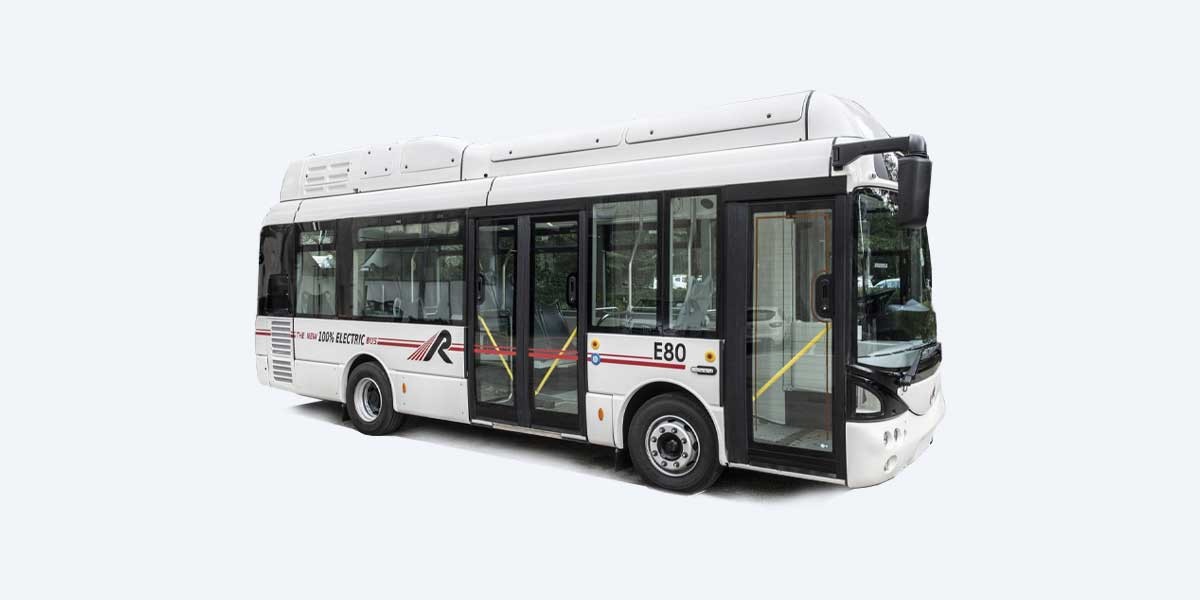RAMPINI E80
User Rating: 3.69 / 5





What is the RAMPINI E80?
RAMPINI E80, an electric minibus, offers efficient urban transport with zero emissions, quiet operation, and a sleek design. The compact size ensures easy maneuverability in crowded areas while providing a comfortable ride for passengers. Ideal for routes in city centers, promoting sustainability.
RAMPINI E80 price:
US$ 0 *
| manufactured in | Italy |
| model year | 2021 |
| range (km) | 200 |
| battery (kWh) | 280 |
| bus type | minibus |
| seats (qty) | 10 |
* Minimum price set by the manufacturer, excluding taxes and additional options

Exterior and Interior photos of RAMPINI E80
RAMPINI E80 Review
The RAMPINI E80 Electric Bus: A Testament to Italian Ingenuity
From the heart of Italy, a nation celebrated for its contributions to art and engineering, emerges the RAMPINI E80 Electric Bus. Birthed in 2021, this paragon of electric transportation swiftly commandeered the spotlight, enchanting both transport aficionados and pragmatic operators with its ecological prowess and stellar performance.
The Green Mileage Prodigy
Flaunting a formidable 280 kWh battery, the E80 serenades the streets with an outstanding voyage capability of up to 200 kilometers. This marvel of engineering intricately dovetails energy thriftiness with peak efficiency, crafting a new benchmark for sustainable urban mobility.
The Nimble Urban Navigator
Conceived as a minibus, the E80 wields its 8-meter stature to host up to 10 passengers in sheer comfort. This spatially sagacious design, meshed with its agility, renders the E80 a darling among city transit curators.
The Odyssey of the RAMPINI E80: A Decade in the Limelight
The genesis of the E80, alongside its brethren the E60 Electric, heralds the esteemed lineage of RAMPINI electric buses. Tracing its origins to the dawn of electric bus manufacture by Rampini, the E80's journey from its inception in 2010 to its current apotheosis encompasses exhaustive trials and myriad enhancements in pursuit of adapting to the dynamic exigencies of the transport domain. Today, it basks in pan-European encomiums for its avant-garde design and steadfast performance.
The Apex of Passenger Accommodation
Despite its compact guise, the E80 electrifies with its unparalleled passenger capacity, ferrying up to 48 individuals with impeccable handling and sovereign autonomy.
A Bastion of Durability: The Self-Supporting Structure
Veering from traditional concepts, the E80 parades a self-supporting architecture, emancipated from a conventional chassis. This innovative construct augments its resilience and elevates the transport experience to uncharted elevations.
A Heartbeat of Electric Traction
At its core, the E80 pulsates with an electric traction system, a brainchild of Rampini's in-house wizards. Energized by lithium ferrite cells, this system orchestrates the bus's operations with finesse, minimizing maintenance interludes.
A Vanguard in Battery Management
Seizing the reins in battery innovation, Rampini unveils a pioneering Battery Management System (BMS) for the E80. This intricate network governs the surveillance and regulation of each cell, ensuring the battery's zenith in health and performance.
In an era yearning for sustainable conduits, the RAMPINI E80 Electric Bus emerges as a beacon of eco-conscious transit. With its roots entrenched in Italian artistry, it sails through the urban landscape, offering a symphony of efficiency, capacity, and visionary design. The RAMPINI E80 Electric Bus: not merely a vehicle, but a harbinger of a greener, more sustainable tomorrow.
Manufacturer: Rampini Carlo
Related Video
Comparison:
In the big, bold, brash world of electric buses, the Rampini E80 stands out with a zero-emission swagger. But how does it stack up against its electrifying competitors like the BYD K9, Proterra ZX5, and the Mercedes eCitaro? Let’s delve into the details.
Speed
The Rampini E80 tops out at a leisurely 45 mph (72 km/h)—perfect for urban jaunts but perhaps a tad pedestrian for intercity travels. The BYD K9, however, stretches its legs to a brisk 60 mph (96 km/h), making it the speed demon of city buses. Meanwhile, the Proterra ZX5 comfortably matches this pace, allowing seamless transitions on the highway. The Mercedes eCitaro lulls the speed challenge, doing a cozy 50 mph (80 km/h). While speed thrills, for urban routes, the E80s modest pace is not a dealbreaker.
Range
In the range department, the Rampini E80 offers a solid 124 miles (200 km) on a full charge. Its peers, however, are a bit more adventurous. The BYD K9 cruises up to 190 miles (305 km), presenting a solid option for longer shifts. The Proterra ZX5 flexes an impressive 240-mile (386 km) range, practically begging to be driven nonstop. Finally, the Mercedes eCitaro offers a respectable 150 miles (240 km), striking an admirable balance.
Power
When it comes to power, the Rampini E80 has a 280 kWh battery, delivering a staunch performance for city routes. But, its dwarfed by the Proterra ZX5s mammoth 660 kWh power pack, promising unrelenting endurance. The BYD K9 sits snug in the middle with a 324 kWh battery, while the Mercedes eCitaro provides a noble 243 kWh of electric might. While the E80 gets the job done, route planning might need a tad more calculation when compared to its bulkier counterparts.
Charging Time
Charging prowess is another battlefield. The Rampini E80 demands a good 3 to 4 hours for a full recharge using its DC fast charging. The BYD K9 lowers the waiting game to approximately 2.5 hours. The Proterra ZX5 takes the crown again, refueling its electric stamina in just under 2 hours, thanks to its Cutaway design for modular batteries. Meanwhile, the Mercedes eCitaro finds itself similar to the E80, clocking around 3 hours for a full tank of electrons.
Price
The Rampini E80 promises to be a steal, coming in at a surprisingly affordable price of $450,000 / £350,000 / €400,000, making it an attractive entry point for cities embracing greener mobility. The BYD K9, with its extended range, sets you back around $600,000 / £460,000 / €530,000. The Proterra ZX5 and all its impressive specs ramp the price up to a princely sum of $750,000 / £575,000 / €665,000. Meanwhile, the Mercedes eCitaro finds itself comfortably priced at $500,000 / £390,000 / €435,000.
So, while the Rampini E80 may lag a smidge in flash and dazzle, it brings practicality and affordability to the table. Each bus has its own charm, tailored to specific needs—whether it’s the breathtaking range of the Proterra ZX5 or the joyful sprint of the BYD K9, the choice comes down to matching those eclectic specifics to one’s public transit agenda.
F.A.Q.:
How far can the electric bus/van travel on a single charge?
The RAMPINI E80 can travel approximately 200 kilometers (124 miles) on a single charge.
What is the battery capacity and how long does it last?
The battery capacity of the RAMPINI E80 is 280 kWh, and it typically lasts around 6-8 years depending on usage and maintenance.
How long does it take to charge the bus/van fully?
It takes about 3-4 hours to fully charge the RAMPINI E80 using a high-power 100 kW charging station.
Are there sufficient/accessible charging stations available for the route?
Charging infrastructure is rapidly expanding, and it is advisable to plan your routes in advance to ensure sufficient charging stations are available on your route.
What is the upfront/initial purchase price of the electric bus/van?
The initial purchase price of the RAMPINI E80 is approximately €400,000 ($420,000 or £345,000).
How do maintenance and operating costs compare to traditional buses/vans?
Maintenance and operating costs of the RAMPINI E80 are lower compared to traditional diesel buses, due to fewer moving parts and reduced fuel costs.
How does the bus/van perform in different weather conditions and terrains?
The RAMPINI E80 performs well in various weather conditions and terrains, thanks to its robust design and electric drivetrain.
What is the energy efficiency of the bus/van?
The RAMPINI E80 is highly energy efficient, with an average consumption of about 1.4 kWh/km (0.88 kWh/mile).
How many passengers can the bus accommodate?
The RAMPINI E80 can accommodate up to 80 passengers, providing ample space for commuters or school children.






